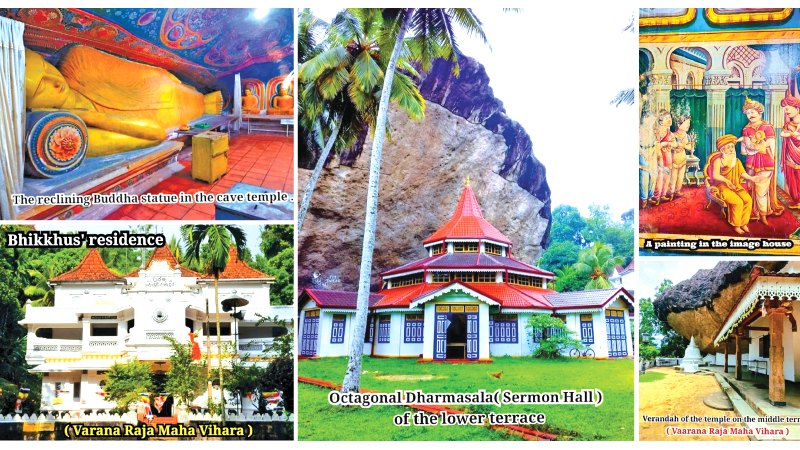Historical Varana Rajamaha Vihara in Siyane Korale-by S.K. Tissera, Chilaw Group corr
Image Source:Sundayobserver
Source:Sundayobserver
The Varana Raja Maha Vihara in Siyane Korale in the Gampaha district is a historically significant cave temple which is in a rocky area close to a vast stretch of paddy field surrounded by a picturesque, tranquil, green environment. This ancient temple with its unusual geographical location can be reached from Yakkala, Nittambuwa and Thihariya on the Colombo- Kandy road. The historical Raja Maha Vihara thought of as the largest forest monastery in the Gampaha district can be seen one and a half miles away from the Nelligahamula junction on the Yakkala – Kirindiwela road.
Despite being a less-known Buddhist place of worship, it has in its three terraces so many must-see artefacts and relief features probably marvelled at by whoever gets there. A wonder of nature later turned into an open art gallery with awe-inspiring masterpieces worth catching at least a glimpse of during one’s lifetime was made into what it is today under the patronage of King Devanampiyatissa (307BC -267 BC ), King Valagamba (103BC and c. 89-77 BC), King Nishshankamalla (1187AD- 1196 AD), King Krithi Sri Rajasinghe (1747 AD – 1782 AD) and King Parakramabahu VI (1412 AD – 1467 AD).
The temple was called in the past Mangala Raja Maha Vihara since it is in the village called Mangalathiriya. But later it came to be known as Varana Raja Maha Vihara due to several reasons.
The first reason is that the rock where the temple is situated resembles an elephant. As the word Varana is one used to refer to elephants, it is believed that the temple came to be known as Varana Raja Maha Vihara. The other reason is associated with a type of tree called Va which is abundantly found in the area where this temple is located. The word Varana is supposed to have been derived from Va-arana.
This sacred Buddhist monastery complex comprises three parts as lower courtyard, middle courtyard and upper courtyard. In the lower terrace of the temple is a rock called Idamgala which is about 100 ft. high and has spread over an area of more than one acre. Attached to it, there is a drip-ledged cave with a unique, impressive octagonal sermon hall.
The drip-ledged cave temple in the middle terrace houses a row of beautiful Buddha statues unique in Sri Lanka and ancient paintings on the rock-ceiling, which belongs to the Kandy period. Most of the murals on the canopy can be seen to depict lotus flowers typical of those found in the temples belonging to the Kandyan-era. Also, there is a small stupa built under the rock shelter. The roof of the verandah of the cave temple is supported by 14 stone pillars. On them are wooden beams with exquisite floral designs engraved.
Several well-preserved, meticulously-crafted moonstones are a major attraction in this middle courtyard where there is a pohoya house too. The moonstone in the middle courtyard, which resembles the one in Biso Maligaya in Anuradhapura, is said to be one of the four best moonstones in Sri Lanka.
A steep flight of more than 150 steps leads to the upper courtyard which has another ancient stupa, a cave temple and a pond beside which is a magnificent rock formation. The second largest recumbent Buddha statue of this rock monastery is in the cave temple in this upper terrace of the temple.
The old stone inscription found at a site to the East of Idamgala within the temple premises shows that this area had been inhabited by people from time immemorial, by extension, from the 6th century, hence the belief that the area must have been sparsely populated even at the time when Buddhism was brought to Sri Lanka.
The historical Varana Rajamaha Vihara in Siyane Korale has much to offer visitors and, therefore, is worth visiting at least once to gain first-hand experience of living Buddhist heritages in their pristine grandeur and splendour.








